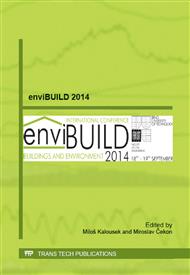p.121
p.125
p.129
p.135
p.139
p.146
p.150
p.154
p.158
Heat Supply Optimization
Abstract:
Due to the energetic evaluation of buildings, the solutions for optimal heat supply are a problem of current interest. The topicality of this problem is underlined by the European Union requirements for reducing the energetic demands of buildings by the year 2020.From the operational point of view, most of the heating systems seem to be optimal; however, with the use of the results of this detailed analysis it is possible to make even further improvement. The objective is not to supply more heat energy than necessary in order to achieve energy saving. This reduction of heat supply can be achieved by the use of the heat accumulation potential of the building by means of appropriately chosen heating mode. By operation modes are meant a mode with constant heating and a mode with interrupted heating.In this sample case of non-stationary simulation during the interrupted heating regime it is possible to demonstrate the potential saving achieved by the chosen interrupted heating mode. The case study is conducted on a secondary school building. In this project, supported by the specific investigation project on the Faculty of Civil Engineering, I carried out an experiment of an interrupted mode, which was also supported by a theoretical part, in which a non-stationary calculation was used.This contribution suggests the possibility to save energy by optimization of the heat supply. It also presents the difference between a stationary and non-stationary solution to this problem.
Info:
Periodical:
Pages:
139-145
Citation:
Online since:
October 2014
Authors:
Price:
Сopyright:
© 2014 Trans Tech Publications Ltd. All Rights Reserved
Share:
Citation:


